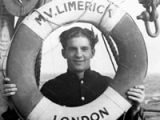What happened that day?
See historic events for any day of the year by entering the date below. Why not try your birthday?
Kiwi of the Week
Today in History

1943 NZ ship torpedoed in Tasman
Like many New Zealand merchant ships, the 8684-ton Union Steam Ship Company freighter Limerick undertook a number of military missions during the Second World War, carrying munitions, food, equipment and personnel between New Zealand, Australia, North America and the Middle East.
On the night of 25/26 April 1943, the Limerick was sailing in a small convoy from Sydney to Brisbane. Around 1 a.m., off Cape Byron, New South Wales, it was torpedoed by the Japanese submarine I-177. Two of the crew – a New Zealand engineer and an Australian officer – went down with the ship. The other 50 or so were rescued after spending 10 hours in lifeboats or on rafts.
Although the Tasman Sea was not a major hunting ground for enemy submarines, in 1942–43 up to 10 Japanese ‘I-boats’ operated off Australia’s east coast, sinking 18 merchant ships. In the deadliest attack, I-177 sank the Australian hospital ship Centaur with the loss of 268 lives. As well as the Limerick, New Zealand’s Union Company lost the small freighter Kalingo, which was torpedoed by I-21 110 km east of Sydney on 18 January 1943. Two of its crew were lost; the remainder were rescued after spending three days in a lifeboat.

2005 Civil unions come into effect
Couples − heterosexual or homosexual − were now able to register their relationship as a civil union. The change meant that all couples in New Zealand, whether married, in a civil union or in a de facto partnership, now had equal rights and obligations.




















